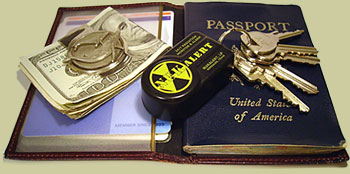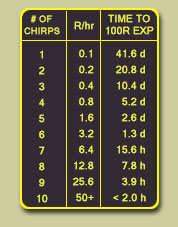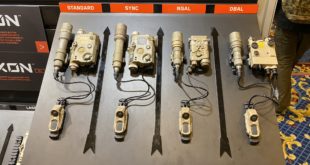by David Crane
david@defensereview.com
 losing 10-30 square blocks (depending on the power of the respective bomb) in the downtown area of just one major U.S. city. Now imagine it happening in 5-7 U.S. cities simultaneously (or in rapid succession). It’s mind-boggling in scope and effect, and perhaps difficult to imagine. But, then again, none of us ever thought we’d see commercial aircraft flying into the World Trade Center and those towers come tumbling down in front of our very eyes on live television, either–or the Pentagon getting attacked, for that matter. If someone had told us before 9/11 what was going to happen, we probably would have thought that person was crazy. It’s still sometimes hard to get one’s mind around 9/11. But, let me tell you, 9/11 was nothing compared to what can happen to us if the bad guys (radical Muslims a.k.a. Islamo-Fascist terrorists) get their way. Make no mistake, that’s what they want to do, and that’s what many hard-working and dedicated people in our government are doing their absolute best to prevent. Let’s just hope the good folks in the U.S. military and the U.S. Department of Homeland Security can get the bad guys before the bad guys get us.
losing 10-30 square blocks (depending on the power of the respective bomb) in the downtown area of just one major U.S. city. Now imagine it happening in 5-7 U.S. cities simultaneously (or in rapid succession). It’s mind-boggling in scope and effect, and perhaps difficult to imagine. But, then again, none of us ever thought we’d see commercial aircraft flying into the World Trade Center and those towers come tumbling down in front of our very eyes on live television, either–or the Pentagon getting attacked, for that matter. If someone had told us before 9/11 what was going to happen, we probably would have thought that person was crazy. It’s still sometimes hard to get one’s mind around 9/11. But, let me tell you, 9/11 was nothing compared to what can happen to us if the bad guys (radical Muslims a.k.a. Islamo-Fascist terrorists) get their way. Make no mistake, that’s what they want to do, and that’s what many hard-working and dedicated people in our government are doing their absolute best to prevent. Let’s just hope the good folks in the U.S. military and the U.S. Department of Homeland Security can get the bad guys before the bad guys get us.
So, what does DefenseReview think about the possibility of a nuclear attack (or multiple attacks) on our soil? We don’t know. We hope the people we’ve spoken with who think we’re in for some real big trouble in the not-too-distant future are 100% wrong, and that the domestic nuclear attack they envision never comes. What’s disturbing about it, though, is that these people (who believe we’re going to suffer this type of attack) aren’t crazy survivalists or tin foil hat wearers. Some of them are highly trained professionals who are (in some cases) responsible for the security of our nation.
 So, why am I writing about this? Well, 1) because I think it’s relevant and important to at least touch on it once, however briefly, and 2) I recently received a nifty little item in the mail from Shane Connor at KI4U, Inc. that could potentially (eventually) prove to be a real life saver, or, at the very least, give the owner some peace of mind–or scare the hell out of him/her–if the above-outlined scenario were ever to occur (God forbid). After all, Defense Review is a tech site (i.e. tactical/defense technology site). This is what we do.
So, why am I writing about this? Well, 1) because I think it’s relevant and important to at least touch on it once, however briefly, and 2) I recently received a nifty little item in the mail from Shane Connor at KI4U, Inc. that could potentially (eventually) prove to be a real life saver, or, at the very least, give the owner some peace of mind–or scare the hell out of him/her–if the above-outlined scenario were ever to occur (God forbid). After all, Defense Review is a tech site (i.e. tactical/defense technology site). This is what we do.  If dangerous nuclear radiation (i.e. nuclear fallout) is present in the air, the NukAlert will start "chirping" in repeating groups of rapid countable "chirps". A table on the back of the unit allows the owner to determine the the actual radiaton level. BTW, under normal conditions (no radiation), the NukAlert just makes a constant faint ticking sound. The device utilizes a patented CdS photo resistor coupled to a rare earth phosphor scintillator to detect radiation to do its magic, and it operates continuously, 24/7. Operational life expectancy for the NukAlert is 10-15 years under normal conditions (non-alarming). It will alarm continuously at the single chirp level for approx. 3 years, and at the highest chirp level (again, continuously) for 3 months.
If dangerous nuclear radiation (i.e. nuclear fallout) is present in the air, the NukAlert will start "chirping" in repeating groups of rapid countable "chirps". A table on the back of the unit allows the owner to determine the the actual radiaton level. BTW, under normal conditions (no radiation), the NukAlert just makes a constant faint ticking sound. The device utilizes a patented CdS photo resistor coupled to a rare earth phosphor scintillator to detect radiation to do its magic, and it operates continuously, 24/7. Operational life expectancy for the NukAlert is 10-15 years under normal conditions (non-alarming). It will alarm continuously at the single chirp level for approx. 3 years, and at the highest chirp level (again, continuously) for 3 months. Cool product. It definitely gets the DefRev thumbs-up.
– Sensitivity: 100 mR/hr to 50 R/hr indicated in 10 ranges
– Indication: Repeating groups of rapid countable chirps
– Operational indicator: faint "ticking" = operating OK.
– Alarm loudness: ~ 61 dBA (speaking volume)
– Durability: Functional after 6′ drop or submersion to 6′
Battery: Operational Life Expectancy @ room temp:
– Non-alarming (normal operation) – 10 to 15 years
– Alarming continuously at single chirp level – 3 years
– Alarming continuously at highest alarm level – 3 months
– See New Battery Replacement Program
– Detector: Patented CdS photo resistor coupled to a rare earth phosphor scintillator
– Housing: hermetically sealed, radiation transparent, abrasion resistant ABS plastic – Accuracy: Within +/- 1 chirp
– Response Time: Dose rate dependent:
~3 – 4 min. @100mr/hr
~4 – 5 sec. @ R/hr ranges
– Accumulated dose chart on back
– EMP immunity: Meets MIL-STD-461D, RS105
– Over range survivability: Functional after 5K R/hr. for 2hr.
– Temperature Range: -20 C to +50 C
– Physical: 1.75"x1.25"x .75"H (LxWxH), Wt <1.0 oz.
 DefenseReview.com (DR): An online tactical technology and military defense technology magazine with particular focus on the latest and greatest tactical firearms news (tactical gun news), tactical gear news and tactical shooting news.
DefenseReview.com (DR): An online tactical technology and military defense technology magazine with particular focus on the latest and greatest tactical firearms news (tactical gun news), tactical gear news and tactical shooting news.


